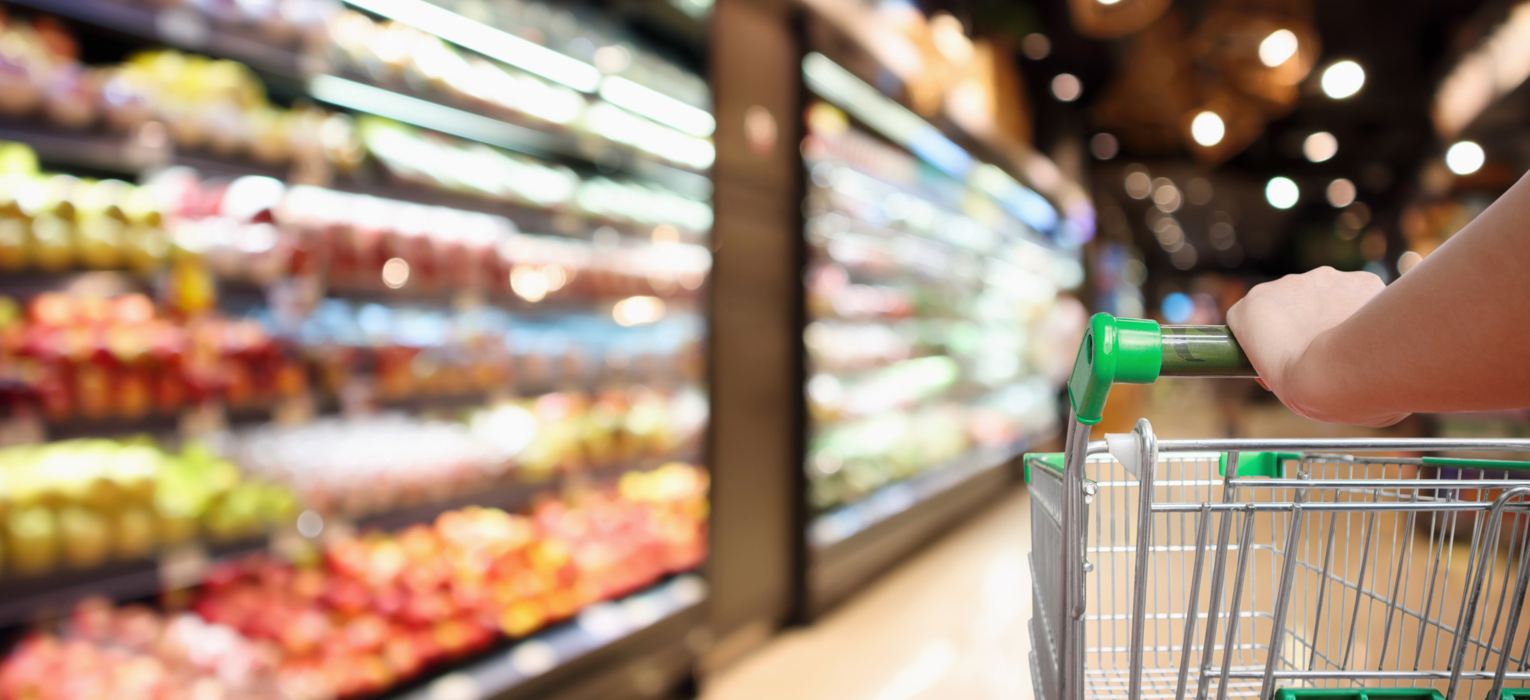The food industry is a vast and dynamic ecosystem that relies heavily on science, creativity, consumer demand, market trends, and efficiency to stay ahead.
In recent years, data collection and analysis have powered the rapid advancement of artificial intelligence (AI), which has brought significant transformations across various industries, and food brands are no exception. From enhancing product development, targeting consumer demands, optimizing supply chains, and driving increased food safety, AI is revolutionizing how food brands operate. Here, we explore AI’s profound impact on the food industry and the opportunities it presents for brands to grow, innovate, and increase customer satisfaction.
The AI in Food and Beverage market is projected to reach USD 311.6 billion by 2033, exhibiting a robust compound annual growth rate (CAGR) of 43.7% from 2024 to 2033.
Food companies are leveraging cutting-edge technologies like artificial intelligence (AI) and machine learning to scale operations, reduce labor costs, and maintain relevance in a dynamic market landscape. Additionally, AI’s pivotal role in enhancing efficiency, minimizing waste, bolstering food safety measures, and enabling personalized nutrition solutions is a significant catalyst driving market expansion.
Using Constrained AI and deep learning for confidence and security.
AI is in its infancy. It is a tool to use within a more extensive set of approaches within food, science, and business that is better suited to some tasks or portions of tasks but not all.
At Creme Global, we use a constrained conditional model (CCM). This is a type of AI model that is used to find the best possible solution to a problem within a set of constraints. This advanced approach to training robust deep neural networks by incorporating constraints into the learning process. These constraints can be based on physical laws, logical rules, or any other domain-specific knowledge to ensure confidence and security in the output.
1. Drive better business decisions
AI empowers food brands to make more informed and data-driven decisions, ultimately improving their strategic planning and operational efficiency. Advanced analytics tools powered by AI can process and interpret vast amounts of data, from market trends to consumer behavior and internal performance metrics. By leveraging this intelligence, food businesses can gain insights that inform their marketing strategies, product launches, and financial investments.
For instance, predictive analytics can help brands anticipate market shifts and adapt their offerings accordingly. This data-driven approach supports agile decision-making, allowing food brands to pivot quickly and seize new opportunities while mitigating potential risks. AI-powered food trends also help decision-makers identify underperforming areas, enabling them to reallocate resources effectively and prioritize efforts that drive the most value.
2. Product development and innovation. AI platforms for food innovation.
One of the most exciting applications of AI for food brands is in product development. AI-driven tools can analyze large data sets to identify emerging consumer preferences, predict flavor trends, and even create new recipes. By processing data from social media, online reviews, and sales figures, AI can help food brands anticipate what customers want before it becomes mainstream. This capability enables brands to be proactive rather than reactive, giving them a competitive edge in launching successful products.
For example, AI algorithms can analyze patterns from millions of data points to suggest new flavor combinations or ingredients that consumers are likely to embrace. Food giants like McCormick have already utilized AI to develop new seasoning blends with higher precision and faster turnaround times, demonstrating how technology can bridge the gap between consumer desire and product availability.
AI platforms for food innovation can take on various roles, including analyzing massive sets of consumer data, monitoring food trends, and predicting upcoming flavor profiles that align with consumer tastes. These platforms allow brands to test new ideas in a virtual environment, significantly reducing the cost and risk associated with traditional product testing.
Accelerating recipe development
Traditionally, developing a new food product involved extensive trial-and-error, a process that could take months or even years. AI platforms expedite this process by suggesting recipes based on current consumer data, nutritional guidelines, and flavor pairings that are likely to succeed. For instance, AI can simulate thousands of flavor combinations, nutritional profiles, and ingredient interactions to generate recipes that meet specific criteria, such as being vegan, gluten-free, or low in sugar. This rapid prototyping reduces the time and resources spent in research and development, allowing food brands to bring innovative products to market faster.
Dr. Doyle, alongside Conor Cahill, Head of Science & Innovation at Dawn Farms, gave a joint presentation recently at the Maple Leaf Foods Annual Food Safety Symposium on the successes of the PeRCEPTION project.
Creme Global’s Perception software is an advanced AI platform designed to bring unparalleled efficiency to food product development. Imagine being able to predict the consumer appeal of a new food product before creating a physical prototype.
Perception enables companies to make highly informed decisions early on, optimizing formulation, health benefits, and sustainability considerations—all of which streamline product development and reduce time and cost.
With Perception, the food industry can digitalize sensory experiences by capturing taste, appearance, and texture data. This makes it an invaluable tool for developing products that meet consumer expectations and industry standards right from the start. The platform is engineered to increase efficiency by ensuring new products align with consumer trends, regulatory standards, and sustainability goals, thereby significantly reducing the number of trial-and-error cycles in product development.
3. Streamlining the supply chain
AI is also making waves in the logistics and supply chain management aspect of food brands.
Complexities include:
- Moving perishable goods in a timely manner.
- Moving food products between different food sectors with differing food safety standards.
- Maintaining inventory levels.
- Minimizing food waste.
- Ensuring food security.
- Accurate demand forecasting
- And keeping all that in a sustainable and profitable business margin.
These have long been challenges in the industry. AI-powered tools help streamline these processes by predicting demand more accurately and optimizing delivery routes to reduce costs and environmental impact.
Predictive analytics, powered by AI, can foresee potential supply chain disruptions and suggest alternative solutions. For example, machine learning algorithms can analyze weather patterns, historical data, and other factors to predict shortages or delays in specific supply routes. This helps brands stay agile, ensuring that products reach shelves on time without overstocking or understocking.
Case Study – Dubai Customs
Dubai Customs has implemented a range of AI-driven tools to enhance customs and border inspections, improving efficiency, accuracy, and trade facilitation. Key technologies include the Dubai Customs AI Platform, which enables developers to create solutions for process automation; the Post Clearance Audit Robotic Process Automation (PCA-RPA) for streamlined compliance audits; and the iDeclare mobile app, allowing travelers to electronically submit customs declarations with automated duty calculations. Other tools like Al Munasiq (“The Harmonizer”) assist in classifying goods with AI-driven Harmonized System (HS) codes, while remote inspection robots equipped with thermal and infrared cameras enable offsite inspections. Additionally, a Virtual Reality (VR) training program enhances inspector readiness through immersive simulations. These initiatives showcase Dubai Customs’ commitment to leveraging AI for secure, efficient trade and border operations.
4. Enhancing food safety and quality control
Food safety and quality control are non-negotiable priorities for food brands. AI has introduced new methods for ensuring products meet stringent quality standards. Machine learning algorithms can analyze data from production lines in real-time, detecting anomalies that could indicate a problem. This not only helps prevent costly recalls but also protects consumers from potential health hazards and avoids unnecessary waste.
For instance, AI can be employed in visual inspections, using computer vision technology to identify defective products on assembly lines. Additionally, data-driven AI models can predict the shelf life of products more accurately before production, helping brands make better decisions about storage and distribution to maintain quality.
5. Food sorting and production and manufacturing
Food sorting is the primary step in a supply chain and AI can do it efficiently and accurately with reduced risk of error. This eliminates the need for employees to manually sort food products in an assembly line.
6. Sustainable practices
Sustainability has become an essential focus for food brands looking to resonate with environmentally conscious consumers. AI plays a critical role in achieving sustainability goals by helping brands reduce waste, lower their carbon footprint, and improve resource management. Machine learning algorithms can identify areas in the production and distribution process where energy and resources can be conserved.
Furthermore, AI-powered forecasting tools can optimize ingredient sourcing by assessing the environmental impact of suppliers and choosing the most sustainable options. This not only supports environmental objectives but also enhances the brand’s reputation among consumers who value eco-friendly practices.
7. Optimize yield for farmers
AI is not just a tool for food brands—it extends its benefits to the very start of the food supply chain by assisting farmers and their agricultural practices. Optimizing yield and increasing productivity are crucial for meeting global food demands and supporting sustainable practices. Precision farming, precision agriculture and smart farming tools, enable farmers to monitor crop health, predict yields, and manage resources more efficiently.
For example, remote sensors and drones assess crop conditions, detecting early signs of diseases or pest infestations, and recommend targeted interventions. Machine learning algorithms analyze weather patterns, soil conditions, and historical crop data to provide farmers with actionable insights on when and how to plant, irrigate, and harvest for optimal results. These tools help farmers maximize their yields, reduce waste, and minimize the use of water, pesticides, and fertilizers, contributing to both profitability and sustainability.
OurGreenlink project with Western Growers is one such example.
8. Waste reduction
Food waste is a critical challenge faced by food brands, with significant implications for both profit margins and environmental impact. AI helps combat this issue by providing solutions that track and manage inventory more effectively. Machine learning algorithms can predict demand accurately, reducing the risk of overproduction and ensuring that perishable products are used before they expire.
AI-driven supply chain optimization also plays a crucial role in reducing waste. By analyzing real-time data from various points in the supply chain, brands can identify inefficiencies and make adjustments to prevent spoilage or damage during transportation. For example, AI can recommend adjustments to delivery schedules based on traffic data, temperature forecasts, and route conditions to minimize delays and ensure that products reach their destination fresh and intact.
9. Improve efficiency and reduce operational costs
Operational efficiency is vital for food brands to remain competitive, and AI offers a wide range of tools that streamline processes and reduce costs. From automating repetitive tasks to optimizing workforce management, AI helps businesses allocate resources more effectively. For example, AI-powered data analysis can increase production speed, more accurate production schedules and consistency while minimizing human error and labor costs.
In addition to automation, AI can optimize energy consumption in production facilities. Machine learning models can analyze energy usage patterns and identify opportunities for reducing power consumption, leading to lower utility bills and a reduced carbon footprint. AI can also manage inventory more precisely by predicting the best times to restock products, minimizing holding costs and reducing the likelihood of overstocking.
By applying AI to various aspects of their operations, food brands can streamline processes, reduce waste, and improve productivity, leading to substantial cost savings that contribute to the bottom line.
The Perception project mentioned above enhances operational efficiency by minimizing the manual steps and redundant testing typically associated with New Product Development (NPD). Its predictive capabilities enable companies to forecast consumer preferences, product costs, and sustainability metrics before entering production.
10. Regulation and compliance
Compliance with food safety and regulatory guidelines is paramount for food brands. Failure to meet regulatory standards can result in severe financial penalties, reputational damage, and, most importantly, risk to consumer health. AI assists brands in staying compliant with a myriad of complex food safety regulations by automating data collection and analysis processes.
AI-based tools can track and log data related to production, storage, and transportation, ensuring that all processes adhere to local and international regulations. Machine learning algorithms can also predict potential compliance issues by analyzing historical data, enabling brands to proactively address them before they become problems.
Furthermore, AI-powered platforms can streamline the process of documenting and reporting compliance data. By automatically generating reports and audits, food brands can reduce the burden on human resources and maintain up-to-date compliance records. This not only helps in passing inspections but also in fostering a culture of accountability and excellence in quality management.
11. Trust and reputation
In an age where consumers are increasingly mindful of the origins of their food, transparency is key to building trust and brand loyalty. AI enables food brands to provide greater transparency by tracking products from farm to fork and sharing relevant data with consumers. Blockchain technology, paired with AI, ensures that data related to sourcing, production, and distribution is secure, immutable, and accessible.
For example, food brands can implement AI-driven traceability systems that allow consumers to scan a product’s QR code and learn about its entire journey—where it was sourced, how it was processed, and how it was transported. This level of transparency not only boosts consumer trust but also strengthens the brand’s reputation for honesty and ethical practices.
12. The Future of AI in food branding
The future of AI in the food industry looks promising, with endless possibilities on the horizon. As AI technology continues to evolve, it will become even more sophisticated in predicting consumer needs, streamlining operations, and supporting ethical and sustainable practices.
However, as food brands integrate AI into their operations, it’s important to strike a balance between automation and the human touch that consumers still value. While AI can process data and optimize processes with unmatched speed and precision, creativity and emotional intelligence remain crucial in connecting with consumers on a personal level.
Conclusion
AI is transforming the food industry, enabling brands to innovate, optimize, and personalize their offerings like never before. From developing new products to improving supply chain efficiency and ensuring top-tier quality control, AI is helping food brands adapt to an ever-changing market landscape. Brands that embrace AI today are setting themselves up for a future of innovation, efficiency, and consumer satisfaction. The key is to leverage these technologies thoughtfully, ensuring they complement human expertise and align with a brand’s core values.
As AI continues to advance, it will undoubtedly unlock new opportunities for food brands to not only survive but thrive in an increasingly competitive market. The future of food is smart, and for brands willing to innovate, the possibilities are as diverse and exciting as the flavors they create.



